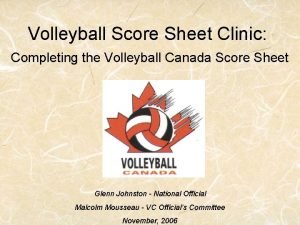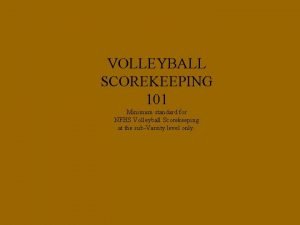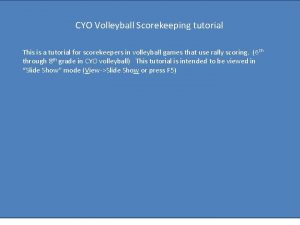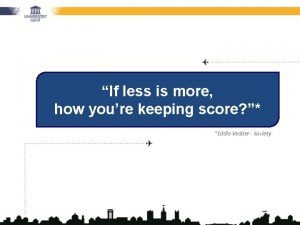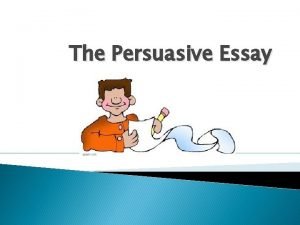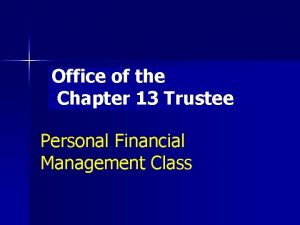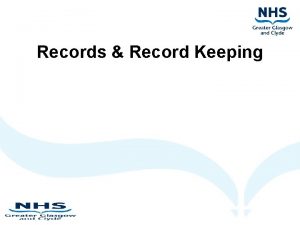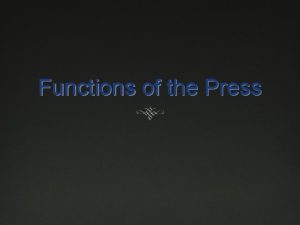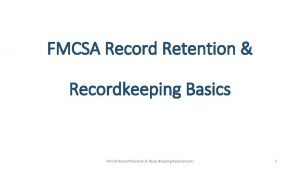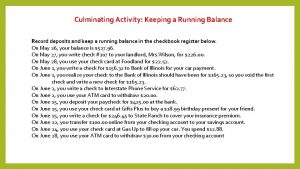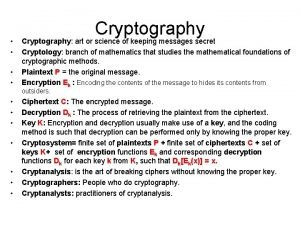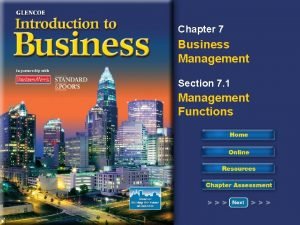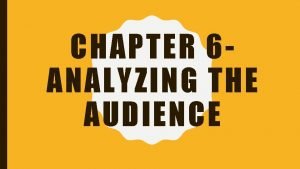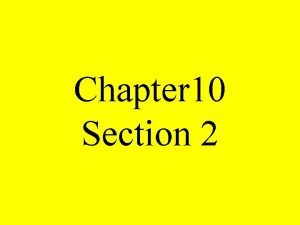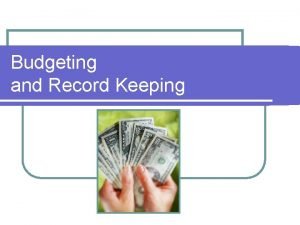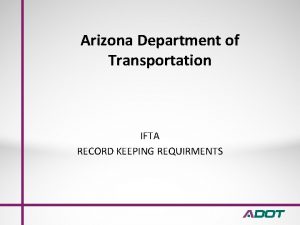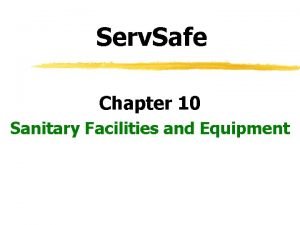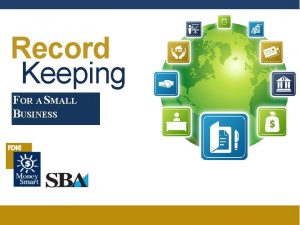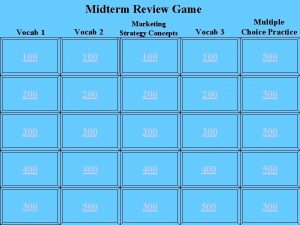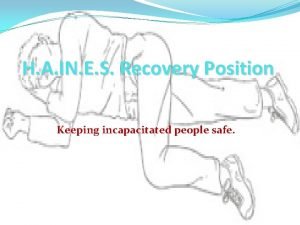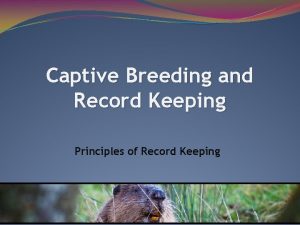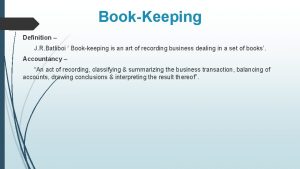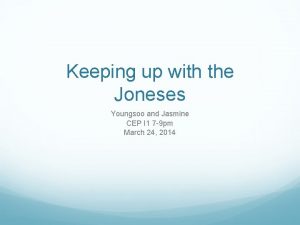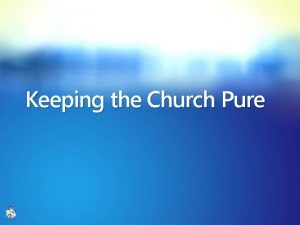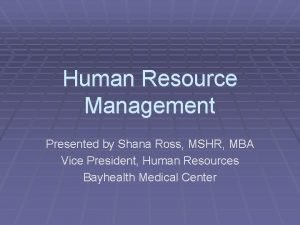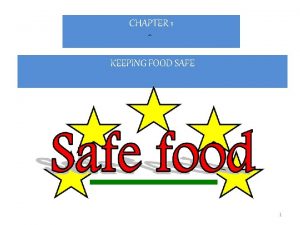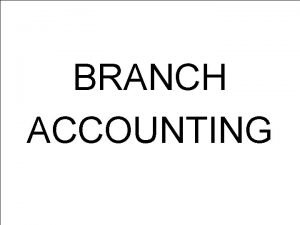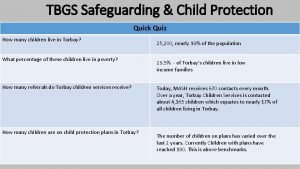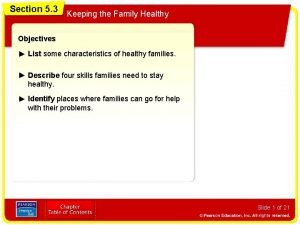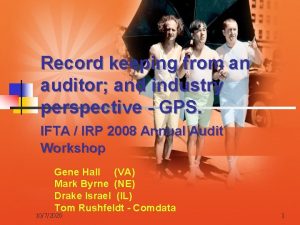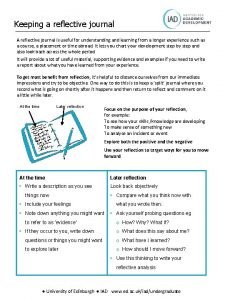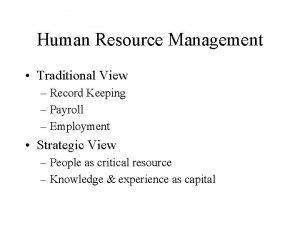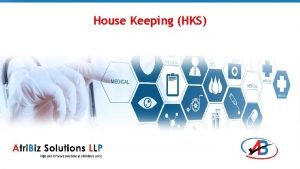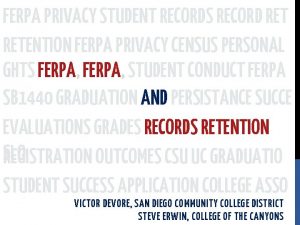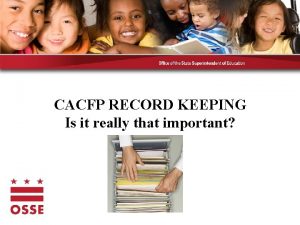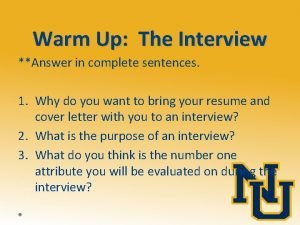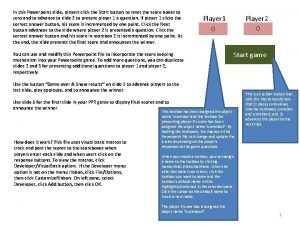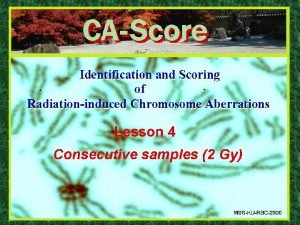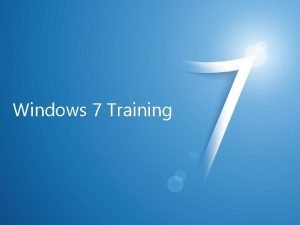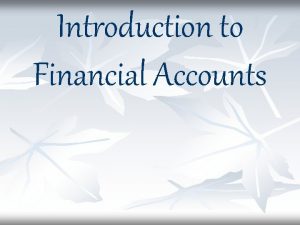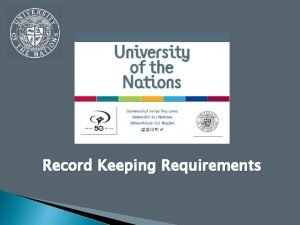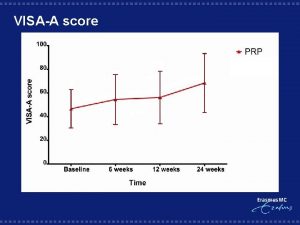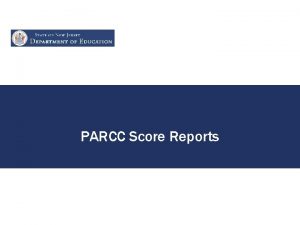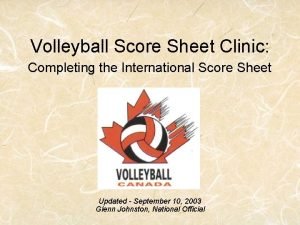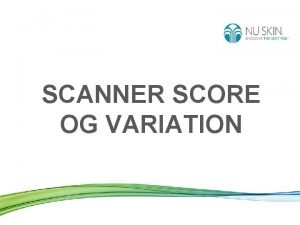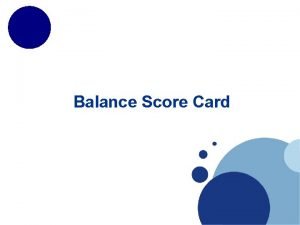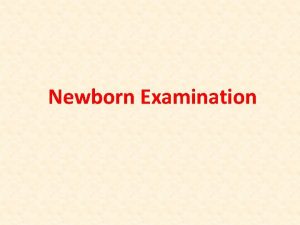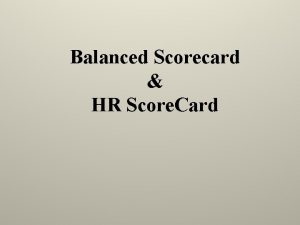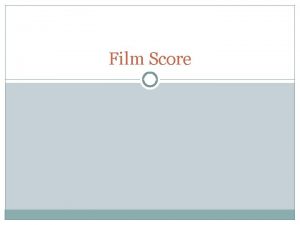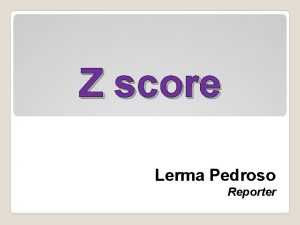Session 4 Keeping Your Financial Score Programataglance Course










































































- Slides: 74

Session 4 – Keeping Your Financial Score

Program-at-a-glance

Course Flow

Remember the Rules of Engagement • • Class participation Work assignments Build your Management Action Plan (MAP) Instructor feedback/coaching

Learning Objectives • When you leave here you will be able to: – Analyse your Income and Cash Flow Statements – Understand links between your statements – Monitor business success by calculating financial ratios – Select Ratios to track on your Financial Scorecard

Session 4 Agenda • 9: 00 am • 9: 30 am Review and MAP Update Financial Analysis II (Ratios and Operating Efficiency) • 12: 00 pm Lunch • 1: 00 pm Lean Principles – 5 S • 2: 00 pm Courageous Conversations • 3: 45 pm Evaluations and Adjourn

Session 3 Review Business Structure and Taxation • Proprietorship • Partnership • Corporation

Session 3 Review A Word About Taxes • Manage assets not taxes

Which method of accounting? Cash basis of accounting • Revenues and expenses are recorded when cash is actually paid or received. A simple method of accounting that is used for tax purposes. Accrual basis of accounting • Revenues and expenses are recorded in the period they are earned or incurred – this method is based on The Matching Principle. More complex than cash basis but a more accurate picture of what has happened in your operation. * The method you choose can affect the decisions you make

The balance sheet Values at a specific point in time What the business owns ASSETS Current Assets Property, plant & equipment at cost less accumulated amort. (note 1) TOTAL ASSETS $ x, xxx, xxx $ x, xxx LIABILITIES What the business owes Value retained in the business Current Liabilities Future taxes payable xxx, xxx Due to shareholders Long-term debt less current portion TOTAL LIABILITIES x, xxx OWNER’S EQUITY x, xxx TOTAL LIABILITIES & OWNER’S EQUITY x, xxx $x, xxx

Income Statement • A statement of the operating activity of the farm • Shows revenues and expenses and the resulting net income (profit or loss) for a specific period of time • Profit/loss is added/subtracted to retained earnings which in turn effects owner’s equity on the balance sheet • Can be prepared on cash or accrual basis – choosing the cash vs accrual can have a significant impact

The income statement What are revenues? • The value of all goods and services rendered by a business as a result of its operations What are expenses? • Goods and services incurred to earn the revenues What is net income? • The amount left after all expenses have been deducted from the revenues – expenses = net income

The income statement • Use it to measure your performance – Understand your operating cycle – Understand the lock up of cash flow • Use it to monitor profitability – Ratio analysis – Session 4

Statement of Income • The statement of income is used to: – Assess the operation’s ability to generate a profit. – Quantify the amount of profit or loss. – Determine why the operation experienced a profit or loss. – Identify how to improve profit. – Track management changes to measure the profit. – Record earnings change to cost basis equity.

Income Statement Component Definitions • • Total Revenues Cost of Production Gross Margin Administrative Expenses Income Before Taxes Income Taxes Other Items (extraordinary items, gain on disposal) Net Income Refer to Appendix E

The income statement Values over a specific period e. g fiscal year Revenues the business earned Expenses the business incurred TOTAL REVENUE TOTAL EXPENSES x, xxx GROSS MARGIN ADMINISTRATIVE EXPENSES INCOME BEFORE TAXES Gain on disposal of property, plant and equipment, taxes x, xxx xxx, xxx NET INCOME (LOSS) The profit of the business for period $ x, xxx (xx, xxx) $ xxx, xxx

Statement of Income Exercise 1. 4 (continued) From Appendix E and G: 10. Locate and record the total revenues 11. Locate and record the total expenses 12. Locate and record the net income 13. Locate and record interest & bank charges 14. Locate and record the amortization of tangible assets $ $ $

Statement of Income Exercise 1. 4 (continued) – Answer Key From Appendix E and G: 10. Locate and record the total revenues 11. Locate and record the total expenses 12. Locate and record the net income 13. Locate and record interest & bank charges 14. Locate and record the amortization of tangible assets $ $ 2, 174, 561 1, 938, 058 290, 207 130, 881 $ 368, 625

Understand operating expenses There are different types of expenses: • Fixed expenses - You incur the expense whether or not you make any sales • Variable expenses - You don’t incur the expense unless you have production • Mixed expenses - Expenses that have both a fixed and a variable component

Fixed expenses • You incur the expense whether or not you have any production • The expense is independent of your volume of sales or revenues • Examples of fixed expenses: – – Equipment insurance Property taxes Loan interest Family member wages

Variable expenses • • • You wouldn’t incur the expense if didn’t have any production The expense varies in relation to the volume of sales or revenues Examples of variable expenses: – Purchase of broiler feed (wouldn’t purchase this if didn’t have a crop of chickens) – Purchase of fertilizer (wouldn’t fertilize if didn’t have crops planted)

Mixed expenses • There are some expenses that have both a fixed component and a variable component: – Heat and hydro For example, in the winter, one will incur the variable cost to add supplemental heat to a barn full of growing broilers – Fuel For example, one will incur an increase in cost to operate machinery during times of higher use such as harvesting

Understand your operating expenses Income statement Revenue less X Selling price Quantity produced X Cost of inputs Cost of goods sold equals Gross margin less Overhead (fixed) costs equals Quantity sold Net income Variable expenses Fixed expenses Mixed expenses

Profitability Ratios The calculation of a business’ ability to generate profit from using its resources • Gross margin % • Net income as a % of revenue • Major expenses as a % of revenue

Major expenses as a percent of revenue • Provides a line by line comparison expenses to your Revenue Cost of sales Gross margin • A valuable ratio to use when comparing trends and industry benchmarks Overhead cost #1 Overhead cost #2 Overhead cost #3 Net income Each expense / revenue x 100% 50% 10% 10% 20%

Exercise 1. 6 - major expenses % Wages and benefits % Long-term interest % Fertilizer and Chemicals % Seed % Using adjusted revenue number to calculate percentage; and appendices E and G

Exercise 1. 6 - major expenses % Answer Key Wages and benefits 4. 18% Long-term interest 6. 91% Fertilizer and Chemicals 13. 8% Seed 11. 30% Using adjusted revenue number to calculate percentage; and appendix E

Remember! Remember that the income statement is key to measuring your performance and monitoring your profitability

The statement of cash flow Cash from operating activities Cash resulting from collecting receivables, paying expenses or purchasing inventory Cash from investing activities Cash resulting from the purchase or disposal of long term assets e. g. equipment Cash from financing activities Cash from borrowing or repaying debt or additional investments or distributions to owners

The statement of cash flow Values at a specific point in time Cash generated during the year OPERATING ACTIVITIES Cash Flow used by operating activities $ INVESTING ACTIVITIES Cash Flow used by investing activities (xxx, xxx) FINANCING ACTIVITIES Cash Flow used by financing activities (xxx, xxx) OTHER ACTIVITIES Cash Flow used by other activities Must match to cash balance on balance sheet xxx, xxx INCREASE (DECREASE) IN CASH FLOW Cash – Beginning of year Cash – End of year (x, xxx) xxx, xxx (xxx, xxx) $(xxx, xxx)

Statement of Cash Flow Exercise 1. 7 From Appendix F: 15. Locate and record the cash generated (or consumed) in each area: a. Operating activities b. Investment activities c. Financing activities d. Other activities $ $ 16. Locate and record the total cash generated (or consumed) during this period $

Statement of Cash Flow Exercise 1. 7 From Appendix F: 15. Locate and record the cash generated (or consumed) in each area: a. Operating activities b. Investment activities c. Financing activities d. Other activities $ $ 1, 038, 229 (245, 000) (352, 268) (16, 293) 16. Locate and record the total cash generated (or consumed) during this period $ 424, 668

Linking the financial statements Source: Farm Financial Records, Page 55

Review of concepts so far… • • • Cash versus accrual method Matching principle Variable, fixed and mixed expenses Balance Sheet Statement of Income Statement of Cash Flow

FINANCIAL RATIOS AND YOUR SCORECARD

Ratio analysis Why bother? • The trends that these ratios highlight are valuable tools for longer-term analysis – Trends, comparison and benchmarking • Lenders use ratios to monitor your financial health • Assist with decision making on business major business transactions

Financial Ratios Five categories of financial ratios: • Liquidity ratios • Solvency ratios • Profitability • Repayment • Efficiency • See hand-out “Farm Financial Scorecard”

Liquidity The ability of a business to meet its financial obligations as they come due in the ordinary course of business Key Ratios: 1. Current Ratio 2. Working Capital

Calculating current ratio • The measure of working capital expressed as a ratio of current assets to current liabilities current assets / current liabilities = current ratio • Health check! – A ratio greater than 1 is preferable but aim for greater than 2 – A high ratio (>4) can indicate inefficient use of resources

Calculating working capital • Net current assets available to finance operations into the next operating cycle current assets – current liabilities = working capital • Health check! – Aim for minimum 3 months expenses

Exercise 4. 2 Calculate Working Capital/Ratio Current assets: $ (A) Current liabilities: $ (B) Working capital: $ (A-B) Working capital ratio: : 1: 00 Using appendix C (A/B)

Exercise 4. 2 Calculate Working Capital/Ratio Answer Key Current assets: $ 1, 168, 269 (A) Current liabilities: $ 383, 806 (B) Working capital: $ 784, 463 (A-B) Working capital ratio: 3. 04 : 1: 00 (A/B) Using appendix C or Answer Key – Exercise 1. 1

Exercise 4. 3 Calculate Months of Working Capital Cash expense: $ (A) Working capital: $ (B) # of Months How long does working capital last?

Exercise 4. 3 Calculate Months of Working Capital Answer Key Cash expense: $ 1, 400, 000 (A) Working capital: $ 784, 463 (B) # of Months 6. 7 Months [B/(A/12)] How long does working capital last?

Linking to the balance sheet Balance sheet Liquidity Assets Current assets Long-term assets Total assets Liabilities Current liabilities Long-term liabilities Total liabilities Owner’s equity Total liabilities & owner’s equity Working capital + Current ratio

Solvency Measure of debt compared to the amount of capital invested in the business Key Figures: 1. Debt to Equity Ratio (Leverage)* 2. Equity to Asset Ratio* *Use a FMV balance sheet

Calculating debt to equity ratio • Compares the usage of debt and equity to finance the farm total liabilities / owner’s equity – A leverage ratio used by lenders who base the calculation on the fair market value of the equity as opposed to book value • Health check! – Lower ratios are preferable; aim for less than 0. 4 – A higher ratio (>. 5) indicates greater long-term risk and less flexibility

Exercise 4. 5 Calculate Debt to Equity (Leverage)* Ratio Total liabilities $ (A) Total equity at FMV $ (B) Leverage ratio $ (A/B) For every $1. 00 in equity, how many dollars of debt? Use appendix C and exercise 1. 3 *Done using FMV

Exercise 4. 5 Calculate Debt to Equity (Leverage)* Ratio – Answer Key Total liabilities $ 2, 696, 009 (A) Total equity at FMV $ 12, 818, 858 (B) Leverage ratio $ 21. 03_%_ (A/B)*100 For every $1. 00 of equity, how many dollars of debt? Use appendix C and exclude due to shareholder *Done using FMV you calculated in exercise 1. 2 • Exclude shareholder debt

Calculating equity to asset ratio • Measures the proportion of assets financed by the owners total equity / total assets – The higher the ratio, the more resources are supplied by the owners as opposed to the creditors. • Based on assets at FMV • Health check! – Higher ratios are preferable; aim for. 5 – A higher ratio indicates more likelihood of solvency

Exercise 4. 6 Calculating Equity to Asset Ratio* Owner’s equity $ (A) Total assets $ (B) Equity ratio % (A/B*100) What percentage of farm assets is financed by the owner? Use appendix C and exercise 1. 3 *Done using FMV

Exercise 4. 6 Calculating Equity to Asset Ratio* Answer Key Owner’s equity $ 12, 818, 858 (A) Total assets $ 15, 514, 867 (B) Equity ratio 82. 62 % (A/B*100) What percentage of farm assets is financed by the owner? Use appendix C and exercise 1. 2 *Done using FMV

Linking to the balance sheet Balance sheet Solvency Assets Current assets Long-term assets Total assets Liabilities Current liabilities Debt to asset ratio Long-term liabilities Total liabilities Owner’s equity Total liabilities & owner’s equity Debt to equity ratio Equity ratio

QUICK BREAK

Financial Ratios ü Liquidity ratios ü Solvency ratios • Profitability • Repayment • Efficiency

Profitability Ratios (covered earlier) The calculation of a business’ ability to generate profit from using its resources • Gross margin % • Net income as a % of revenue • Major expenses as a % of revenue

EBITDA What is it? • Earning Before Interest, Taxes, Depreciation and Amortization • Leases/Rent • Family Wages/Draws

Exercise 4. 7 Calculating Pellegrino EBITDA Income before taxes $ x, xxx Add: Amortization xxx, xxx Interest – long-term xxx, xxx – short-term xx, xxx Amortization xxx, xxx Rents xx, xxx Leases xx, xxx Family wages xxx, xxx EBITDA x, xxx Less family living Available for debt servicing Use appendices C, E and G (110, 500) $ xx, xxxx

Exercise 4. 7 (cont’d) EBITDA $ x, xxx(A) Less: Principal (current portion) $ xxx, xxx Interest – Short-term xx, xxx – Long-term xxx, xxx Rent Lease Surplus Debt servicing ratio How many dollars are available to service commitments? Use appendices C, E and G xxx, xxx x. xxx $ x, xxx(B) x. xx%

Exercise 4. 7 Calculating Pellegrino EBITDA Answer Key Income before taxes $ 236, 503 Add: Amortization 368, 625 Interest – long-term 119, 000 – short-term 11, 881 Amortization Rents 149, 300 Leases 8, 000 Family wages 7, 000 EBITDA – before living 900, 309 Less family living Available for debt servicing Use appendices C, E and G (110, 500) $ 789, 809

Exercise 4. 7 (cont’d) Answer Key Available for debt servicing $ 789, 809 (A) Less: Principal (current portion) $ 383, 806 Interest – Short-term 11, 881 – Long-term 119, 000 Rent – Land Lease 149, 300 8, 000 Surplus Debt servicing ratio How many dollars of surplus are available to service commitments? Appendices C, E and G 671, 981 $ (B) 117, 822 (A-B) 117. 5%

Profitability Ratios • Other to consider… • Return on Assets • Return on Equity • (see handout for details)

Repayment Ratios • Term Debt Coverages Ratio • Debt Service Ratio

Linking to the financial statements Income statement Revenue less Cost of goods sold equals Contribution margin less Overhead (fixed) costs (Adjusted net income) equals Net income Solvency & Repayment Statement of cash flow Cash inflow Cash outflow Opening cash balance Closing cash balance Debt servicing ratio

Calculating debt servicing ratio • Measure of debt service capacity • Indicates the ability to continually generate cash to repay term debt servicing capacity / annual term principal and interest – A linking ratio (links the income statement and balance sheet) – A measure of long-term solvency used by lenders • Health check! – Higher ratios are preferable; aim for higher than 2. 0 – A higher ratio indicates ability to repay term debt

Efficiency Ratios • Asset Turn-over • Operating Expense • Operating Efficiency

Operating Efficiency Formula Measures how well operations produce capacity (cash). How much does it cost to produce $1. 00 of revenue? Operating Costs Divided by Total Adjusted Revenues * 100 Equals Operating Efficiency Percentage *The lower the percent, the better the efficiency.

Operating Efficiency Exercise 4. 1 – use appendices E and G • Adjusted revenue: Revenue Add: Closing inventory Less: Opening inventory Adjusted revenue Operating expenses: Cost of production Less: Opening inventory Short-term interest Rent Leases Other Plus: Administrative expenses Less: Amortization Long-term interest Management wages Other Adjusted expenses $ (A) ( $ $ ( ( (B) Operating expense ration (B) (A) x 100 ( ( ( $ ) ) ) %

Operating Efficiency Exercise 4. 1 – Answer Key - use appendices E and G • Adjusted revenue: Revenue Add: Closing inventory Less: Opening inventory Adjusted revenue Operating expenses: Cost of production Less: Opening inventory Short-term interest Rent Leases Other Plus: Administrative expenses Less: Amortization Long-term interest Management wages Other Adjusted expenses $ (A) $ $ ( (B) Operating expense ration (B) (A) x 100 ( ( $ 2, 174, 561 882, 419 (1, 333, 607) 1, 723, 373 2, 245, 492 (1, 333, 607) (11, 881) (149, 300) (8, 000) ) 574, 985 (368, 625) (119, 000) (7, 000) ) ) 823, 064 45. 75%

Financial Scorecard for Your MAP Chose the ratios that are most applicable to your operation: • Liquidity ratios • Solvency ratios • Profitability • Repayment • Efficiency Which ratios matter to you? Which ratios matter to your banker?

Select and Calculate Your Scorecard Choose some financial metrics that you want to track Scorecard Description/Ratio Total Revenue Avg. Yield or Gain/Day Average Selling Price Choose some ratios that matter to you EBITDA Operating Efficiency % Working Capital Ratio Net Worth 2010 2011 2012 2013 2014 2015 F 2016 F

Summary of Session 4 • • Income Statement Cash Flow Statement Operating Expenses Financial Ratios EBITDA Profitability Ratios Debt Servicing Ratio Efficiency Ratio

Session 4 Agenda • 9: 00 am • 9: 30 am Review and MAP Update Financial Analysis II (Ratios and Operating Efficiency) • 12: 00 pm Lunch • 1: 00 pm Lean Principles – 5 S • 2: 00 pm Courageous Conversations • 3: 45 pm Evaluations and Adjourn

Lunch • After Lunch : Lean Thinking in Agriculture
 Volleyball score sheet example filled out
Volleyball score sheet example filled out Keeping score in volleyball
Keeping score in volleyball Cyo volleyball lineup sheet
Cyo volleyball lineup sheet How youre
How youre Alpha course session 7
Alpha course session 7 The bible course session 3
The bible course session 3 Counterargument
Counterargument Keeping your career on track
Keeping your career on track Half brick wall
Half brick wall Course title and course number
Course title and course number Course interne moyenne externe
Course interne moyenne externe Iscd membership
Iscd membership T score versus z score
T score versus z score Give us your hungry your tired your poor
Give us your hungry your tired your poor Chapter 13 personal financial management course
Chapter 13 personal financial management course Financial risk management syllabus
Financial risk management syllabus Non financial methods of motivation
Non financial methods of motivation Poetic devices in keeping quiet
Poetic devices in keeping quiet Keeping you alive poem hussain manawer
Keeping you alive poem hussain manawer Keeping an infant safe and well section 7-3
Keeping an infant safe and well section 7-3 Nmc record keeping guidance 2009
Nmc record keeping guidance 2009 Keeping orchids poem
Keeping orchids poem Lucozade jackie kay
Lucozade jackie kay Three functions of press
Three functions of press Fmcsa maintenance records form
Fmcsa maintenance records form Culminating activity keeping a running balance
Culminating activity keeping a running balance It is the art of keeping messages secure.
It is the art of keeping messages secure. Promoting infant health section 7-2
Promoting infant health section 7-2 Describe the overall purpose of management
Describe the overall purpose of management Audience centeredness
Audience centeredness Bimetallic stemmed thermometer definition
Bimetallic stemmed thermometer definition Chapter 18 preparing for the world of work
Chapter 18 preparing for the world of work Chapter 11
Chapter 11 An institution for receiving, keeping and lending money
An institution for receiving, keeping and lending money Record keeping and budgeting
Record keeping and budgeting Ifta record keeping requirements
Ifta record keeping requirements Another hobby of mine is keeping fish
Another hobby of mine is keeping fish Keep your city clean
Keep your city clean Lakota keeping of the soul ceremony
Lakota keeping of the soul ceremony Servsafe chapter 10
Servsafe chapter 10 Record keeping for small business
Record keeping for small business Building keeping and growing profitable value-laden
Building keeping and growing profitable value-laden Record keeping and writing
Record keeping and writing Bonang
Bonang Keeping safe on the internet
Keeping safe on the internet Keeping children safe in education 2019
Keeping children safe in education 2019 High arm in endangered spine
High arm in endangered spine Ssszmp
Ssszmp J r batliboi definition
J r batliboi definition Keeping healthy quiz
Keeping healthy quiz Keeping up with the joneses origin
Keeping up with the joneses origin Keeping the church pure
Keeping the church pure Poem on learning
Poem on learning Shana ross bayhealth
Shana ross bayhealth Ankle sprain soap note
Ankle sprain soap note Keeping food safe chapter 1
Keeping food safe chapter 1 How many types of branch account
How many types of branch account Ted safeguarding poster
Ted safeguarding poster Lesson 3 keeping the family healthy
Lesson 3 keeping the family healthy Ifta record keeping requirements
Ifta record keeping requirements V
V Keeping a reflective journal
Keeping a reflective journal Traditional record keeping
Traditional record keeping Housekeeping staff (hks)
Housekeeping staff (hks) Keeping yourself clean
Keeping yourself clean Ferpa record keeping requirements
Ferpa record keeping requirements What is love tank
What is love tank Cacfp record keeping requirements
Cacfp record keeping requirements As a warm-up here's a question that won't affect your score
As a warm-up here's a question that won't affect your score Your score: 1 click here to start playing
Your score: 1 click here to start playing How to raise your r score
How to raise your r score Atrifin
Atrifin Session 0 windows
Session 0 windows Welcome to new session 2020-21
Welcome to new session 2020-21 Session
Session
